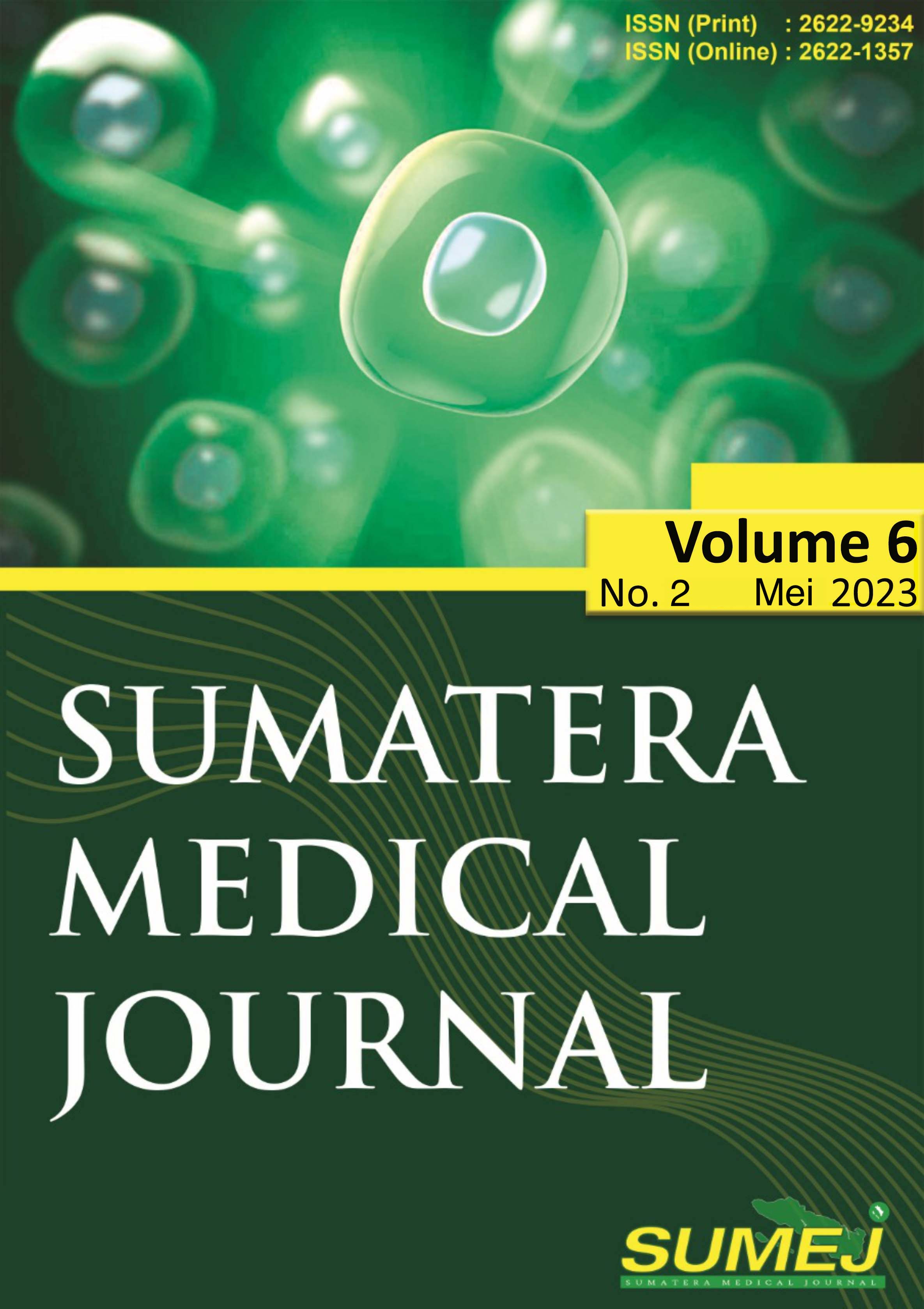Association of Multiple Trauma Referral Distance with Mortality in H. Adam Malik General Hospital Medan
DOI:
https://doi.org/10.32734/sumej.v6i2.11196Keywords:
multiple trauma, mortality, patient transport, referral distanceAbstract
Background: The increasing distance from the location of the trauma to the trauma center can cause an increase in mortality. The farther the distance from the trauma center, the higher the mortality of trauma patients. Geographical variations in care may contribute to the effect of the relationship between distance and mortality in trauma patients. Objective: This study wanted to determine the relationship between multiple traumas referral distances and mortality based on ISS at Haji Adam Malik General Hospital Medan. Methods: The study design was an analytic study with the independent variable being the patient's referral distance and the dependent variable being the predictor of mortality in multiple traumas. The approach used in this research design is a retrospective approach. Results: The mean age of the patients was 31.08±17.82 years. Most of the patients were male, most died, and the average referral distance was 79.67 ± 63,244 km. The majority of the ISS scores were 16. The relationship between referral distance and death in the hospital has a P value of < 0.05. Conclusion: There is a significant relationship between multiple trauma patients' referral distance and hospital mortality.
Downloads
References
Ramadiputra G, Ismiarto YD, Herman H. Survey penyebab kematian berdasarkan prosedur Advance Trauma Life Support (ATLS) pada pasien multiple trauma di Instalasi Gawat Darurat (IGD) Bedah Rumah Sakit Hasan Sadikin Bandung periode Januari–Juli 2014. Syifa’MEDIKA. 2018;9:10–5.
Van Breugel JM, Niemeyer MJ, Houwert RM, Groenwold RH, Leenen LP, van Wessem KJ. Global changes in mortality rates in polytrauma patients admitted to the ICU-a systematic review. World J Emerg Surg. 2020;15:1–3.
Heim C, Bosisio F, Roth A, Bloch J, Borens O, Daniel RT, et al. Is trauma in Switzerland any different? Epidemiology and patterns of injury in major trauma-a 5-year review from a Swiss trauma centre. Swiss Med Wkly. 2014;144:w13958.
Galvagno SM, Nahmias JT, Young DA. Advanced trauma life support® update 2019: Management and applications for adults and special populations. Anesthesiol Clin. 2019;37(1):13–32.
Subdirektorat Statistik Transportasi Badan Pusat Statistik Republik Indonesia. Statistik transportasi darat. Jakarta: Badan Pusat Statistik Republik Indonesia.
El Mestoui Z, Jalalzadeh H, Giannakopoulos GF, Zuidema WP. Incidence and etiology of mortality in polytrauma patients in a Dutch level I trauma center. Eur J Emerg Med. 2017;24(1):49–54.
Gaol HR, Wiargitha K, Widiana GR. Korelasi antara parameter faal hemostasis dan kadar serum laktat sebagai indikator mortalitas pada pasien multiple trauma di Rumah Sakit Umum Pusat Sanglah Denpasar, Bali-Indonesia. Intisari Sains Medis. 2020;11(2):429–33.
Hu W, Dong Q, Huang B. Correlations between road crash mortality rate and distance to trauma centers. J Transp Health. 2017;6:50–9.
Crandall M, Sharp D, Unger E, Straus D, Brasel K, Hsia R, et al. Trauma deserts: Distance from a trauma center, transport times, and mortality from gunshot wounds in Chicago. Am J Public Health. 2013;103(6):1103–9.
Karrison TG, Schumm LP, Kocherginsky M, Thisted R, Dirschl DR, Rogers S. Effects of driving distance and transport time on mortality among Level I and II traumas occurring in a metropolitan area. J Trauma Acute Care Surg. 2018;85(4):756–65.
National Highway Traffic Safety Administration (NHTSA). The association between crash proximity to level 1 and 2 trauma centers and crash scene mortality of drivers injured in fatal crashes. NHTSA’s National Center for Statistics and Analysis. 2012.
Jarman MP, Curriero FC, Haut ER, Pollack Porter K, Castillo RC. Associations of distance to trauma care, community income, and neighborhood median age with rates of injury mortality. JAMA Surg. 2018;153(6):535–43.
Brown JB, Rosengart MR, Billiar TR, Peitzman AB, Sperry JL. Distance matters: Effect of geographic trauma system resource organization on fatal motor vehicle collisions. J Trauma Acute Care Surg. 2017;83(1):111–8.
Greve F, Aulbach I, Mair O, Biberthaler P, Hanschen M. The clinical impact of platelets on post-injury serum creatinine concentration in multiple trauma patients: A retrospective cohort study. Medicina (Kaunas). 2022;58(7):901.
Stengel D, Mutze S, Güthoff C, Weigeldt M, von Kottwitz K, Runge D, et al. Association of low-dose whole-body computed tomography with missed injury diagnoses and radiation exposure in patients with blunt multiple trauma. JAMA Surg. 2020;155(3):224–32.
Centers for Disease Control and Prevention. Scientific data, surveillance, and injury statistics [Internet]. CDC. 2011 [cited 2025 Apr 24]. Available from: http://www.cdc.gov/injury/wisqars.
Ranti JS, Sapan HB, Kalesaran LT. Aplikasi revised trauma score, injury severity score, dan trauma and injury severity score dalam memrediksi mortalitas pada pasien multitrauma di IRDB BLU RSUP Prof. Dr. RD Kandou Manado. J Biomedik. 2016;8(2).
Novianty N. Gambaran cedera kepala dengan multipel trauma ekstrakranial di RSUP Haji Adam Malik Medan Januari–Desember Tahun 2014–2015 [tesis]. Medan: Universitas Sumatera Utara; 2015.
Torabi M, Abadi FM, Baneshi MR. Blood sugar changes and hospital mortality in multiple trauma. Am J Emerg Med. 2018;36(5):816–9.
Setiawan G, Murni TW, Nusjirwan R, Sobarna R. Perbandingan sensitivitas dan spesifisitas Lung Organ Failure Score (LOFS) dan Thoracic Trauma Severity Score (TTSS) terhadap pemakaian ventilator pada pasien trauma multipel disertai trauma tumpul toraks. J Ilmu Bedah Indones. 2019;47(1):69–85.
Cortés-Samacá CA, Meléndez-Flórez HJ, Álvarez Robles S, Meléndez-Gómez EA, Puche-Cogollo CA, Mayorga-Anaya HJ. Base deficit, lactate clearance, and shock index as predictors of morbidity and mortality in multiple-trauma patients. Colomb J Anestesiol. 2018;46(3):208–15.
Heriani N, Wahyuni FN. Correlation between length of reference and severity in head injury patients in Emergency Installation Ulin Hospital Banjarmasin. Health Media. 2019;1(1):1–9.
Burkhardt M, Nienaber U, Pizanis A, Maegele M, Culemann U, Bouillon B, et al. TraumaRegister DGU; German Pelvic Injury Register of the Deutsche Gesellschaft für Unfallchirurgie. Acute management and outcome of multiple trauma patients with pelvic disruptions. Crit Care. 2012;16(4):R163.
Wiratama BS, Chen PL, Chao CJ, Wang MH, Saleh W, Lin HA, et al. Effect of distance to trauma centre, trauma centre level, and trauma centre region on fatal injuries among motorcyclists in Taiwan. Int J Environ Res Public Health. 2021;18(6):2998.
Downloads
Published
How to Cite
Issue
Section
License
Copyright (c) 2023 Sumatera Medical Journal

This work is licensed under a Creative Commons Attribution-NonCommercial-NoDerivatives 4.0 International License.
The Authors submitting a manuscript do so on the understanding that if accepted for publication, copyright of the article shall be assigned to Sumatera Medical Journal (SUMEJ) and Faculty of Medicine as well as TALENTA Publisher Universitas Sumatera Utara as publisher of the journal.
Copyright encompasses exclusive rights to reproduce and deliver the article in all form and media. The reproduction of any part of this journal, its storage in databases and its transmission by any form or media, will be allowed only with a written permission from Sumatera Medical Journal (SUMEJ).
The Copyright Transfer Form can be downloaded here.
The copyright form should be signed originally and sent to the Editorial Office in the form of original mail or scanned document.











